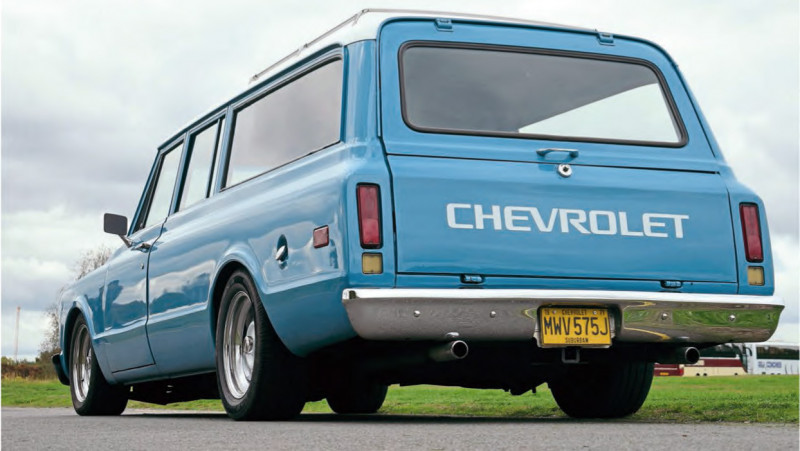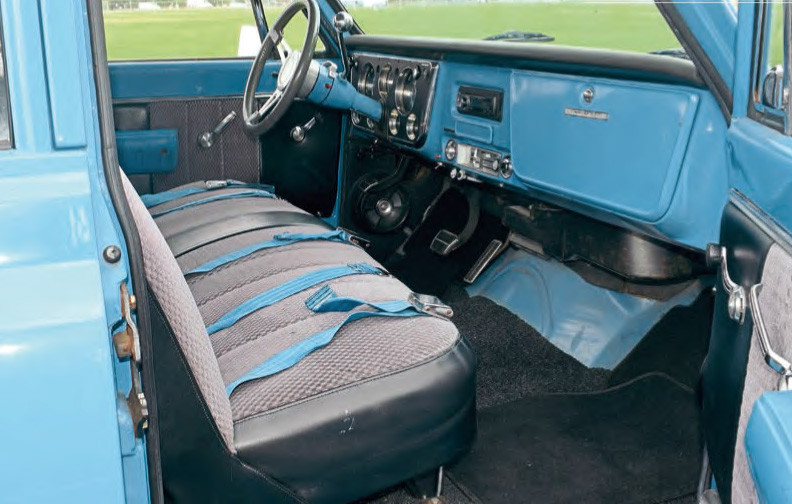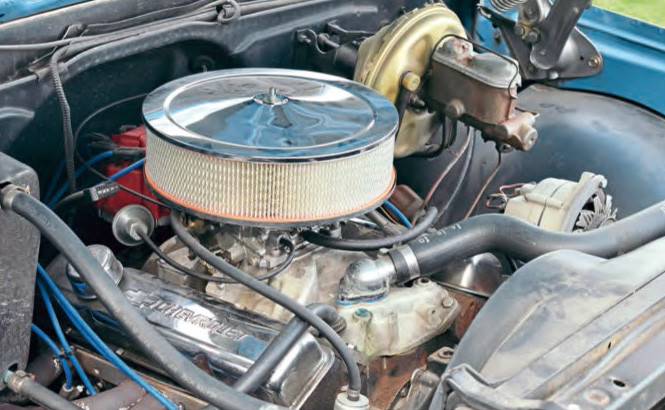1971 Chevrolet Suburban
One doesn’t expect to see a Chevrolet Suburban being filled up with shopping bags in a crowded corner of London. It’s surprisingly usable, though, as Earl Nagy will confirm – he’s the man still driving one as Chevrolet intended...
Words and photography: Zack Stiling
LONDON BUS

“THE REBUILD INVOLVED THE FITMENT OF A NEW 350 CRATE MOTOR FROM SUMMIT RACING, WHICH PRODUCES 350BHP AND WITH EVERYTHING BRAND NEW...”
While we may credit America with the idea of built-in obsolescence, especially in automobiles, a good name never goes out of style. Chevrolet knows this better than most. As of 2023, it has used the Camaro name for 50 years (after a 2002-2009 hiatus), Corvette for 70 years and, most impressively, the Suburban for 88 years, the latter being the longest ever continuous use of a car model name.

This won’t come as news to some readers, but it’s interesting that the longest-lived automobile is one which most people in Britain have never heard of. Unsurprisingly, the Suburban has never been officially sold in Britain, but even among present-day enthusiasts it remains something of an outlier. Apart from the fact that its girth makes narrow lanes, congested streets and finding a parking space difficult, the Suburban’s problem over here may be that to car people it’s a truck, and to truck people it’s a car.

Earl Nagy gets it, though. He appreciates that his 1971 Suburban isn’t strictly a car or a truck – and it certainly isn’t, as some journalists would brand it, the ‘original SUV’ – but rather a combination of both. And unlike many vehicles which attempt to be two things at once, the Suburban excels in both roles.
It probably helps that Earl hails from across the pond. Born and raised in Montreal, Quebec, to a Czech father and English mother, he had an opportunity to appreciate Suburbans in their natural environment. Frequent trips to see family in London turned him into something of an Anglophile, and he settled in London in 1983. Although he owned both British and American cars when in Canada, over here he owned only British cars until 2010, when he felt himself drawn to a 1948 Studebaker Champion.

The Stude was replaced by a 1950 Ford Custom Deluxe Fordor, and the Chevy became its stablemate a few years later. A small collection has now formed, as Earl has more recently added a 1963 Studebaker Daytona Lark. He says: “For a time, I rebelled against American cars because I always loved England, but since I’ve got back into them I’ve not looked back because I really like them. Even the older European cars aren’t as well-made – you’re always tinkering with them. The carburettors, timing and points like to adjust themselves. American cars aren’t like that; as long as you service them, you can always just turn the key and go.”

It can also be seen that he favours the less commonplace models. “Mustangs and Camaros were good cars,” he remarks, “but when I was growing up, everybody had them.”
Certainly, ’71 Suburbans are that much rarer. Indeed, Earl believes his to be unique in this country. It’s a sixth-generation model, as built from 1967 to 1972. You’ll find a handful of fourth- and fifth-generations over here, but they’re a little easier to house. The Suburban’s overall length was little-changed from the first ones in 1935 to the fifth-generation of 1960, which reached 16½ft. The sixth-generation suddenly jumped to 18ft, and successive iterations have grown steadily larger; the latest 2021 Suburban almost stretches to 19ft. Certain Cadillacs and Lincolns may be longer still, but they fare better for their glamour appeal. When I meet Earl at the station, the Chevy is parked at his local Tesco, dominating one-and-a-half spaces. This doesn’t bother him – depending on how much he has to carry, the Suburban and the Lark serve as everyday shopping cars.
He’s mainly used the Ford for shows, so you’re unlikely to have encountered the Chevy except at the NSRA Swapmeet, where it’s ideal for lugging parts home. As we drive to Blackheath to take some pictures, I wonder if Earl doesn’t deserve a medal for not only keeping such a car in day-to-day use in a city which could scarcely be more hostile to it, but also for keeping it in such nice condition. As he remarks: “I remember coming over here in the early Sixties. If you saw one parked car on a street you were lucky. Now you’re lucky if you can find a parking space.”
That being said, the Chevy does all it can to make life easy. It obviously has power steering, so while negotiating London’s tighter spots still requires spatial awareness, it demands no physical effort. And it is perhaps in the Suburban that we see the 350 small-block at its best, not as a hot-rodder’s toy, but as a quiet, dutiful workhorse with the strength of Samson and no mean turn of speed even when fully laden.
Over the course of its life, Chevrolet has transformed the Suburban from a passenger-carrying farm vehicle to a luxury SUV. By the time the sixth-generation was launched, it was still pretty truck-like inside, but one major concession was made to families: the inclusion of a third door, for access to the second row of seats. A third row of seats was an optional extra which made the Suburban officially a nine-seater, although it could take more at a squeeze.
Its appeal to the leisure market by this point is pretty clear. It can comfortably accommodate a large family and the cavernous load area still provides plenty of room for all their camping equipment, bikes and Junior’s Smokey Bear hat, along with whatever else they might need for their vacation at the Colorado River Gorge. With the seventh-generation, a fourth door and folding rear seats became standard equipment, taking the Suburban even further from its agricultural roots.
Earl’s car hasn’t survived with much history, save for the original build sticker on the inside of the glovebox, which tells us that it was built with the LS9 350cu in truck engine and Turbo Hydra- Matic transmission, full wheel covers, front and rear chrome bumpers, a rear seat, push-button radio, and battery, oil and temperature gauges, finished in Medium Blue and White with blue cloth trim.
He bought it in 2018, two years after it was registered in Britain. It had been fully stripped and rebuilt just prior to being imported from Portland, Oregon, where he speculates it may have lived all its life because, he says: “Portland’s a big city, but you don’t have to go far to be rural, so it would be handy for that sort of area.”
The rebuild involved the fitment of a new 350 crate motor from Summit Racing, which produces 350bhp and with everything brand new, from the oil pump, water pump, distributor, carburettor and radiator, to every last hose and belt. The engine was fitted with Magnaflow headers and twin exhaust pipes (it would originally have had a single pipe) and the car also received the more modern 700R4 version of the Hydra-Matic transmission.
The power steering, suspension and brakes were completely renewed, along with a new heavy-duty propshaft and differential. Externally, the original front sheet metal was replaced with the wings, bonnet and grille panel from a ’67 model. The interior was fully retrimmed and then, once the car was over here, it was repainted, although the interior retains its original well-preserved but attractively patinated paint.
The fact that Earl was buying a car which was, in many respects, brand new greatly appealed to him, but the one downside of the rebuild was that the owner at the time elected to lower it by way of fitting shorter springs. He opines: “For what they paid, air suspension would have been the better option, but in America the roads are flat and straight and there are no sleeping policemen.”
A car the size of the Suburban is something a lot of people would be afraid to drive, especially around such a crowded part of London, but Earl waxes lyrical about it. “When I first saw it, I just liked it. I saw it for sale and ummed and aahed over it. It disappeared but then it came up again. I’ve got it for when I need to haul stuff around. If my freezer breaks and I have to go to Currys for a new one, I can just throw it in the back. I haven’t had to do anything to it because it had all been done, every pipe, every hose, every clip…
“You’ve got to be aware of its size, but it’s extremely easy to drive, a dream, as long as you know its width and length. It stops on a dime and turns well – it’s like an original Mini, but with power brakes… Because of the suspension, you do have to watch for potholes. I’ve had 18mpg from it on motorways, but if I was scared of buying petrol I wouldn’t run a car this size.” Now that the last FX4 taxis and Routemaster buses have been consigned to history, London’s streets aren’t as interesting as they once were. Earl may only drive American cars to please himself but, as long as he does, the capital’s that much nicer for it.

Above: Build sheet. Right: Engine is a 350 Chevy small-block V8. Brake booster looks to have been replaced quite recently.
’71 is part of the sixth-generation Suburban. Seatbelts in back and front. Perfect for hauling parts from swap meets.
Power steering makes life easier. Split tailgate the perfect venue for a tailgate party.
Suburban is one of three of Nagy’s Yank collection. Dash is shared with… Plain no-nonsense interior. … the C10 pick-up. Earl Nagy in the US back in the 70s.


